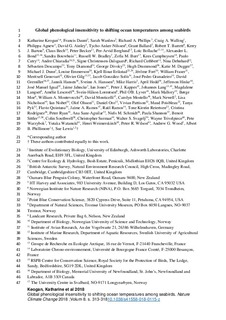Global phenological insensitivity to shifting ocean temperatures among seabirds
Keogan, Katharine; Daunt, Francis; Wanless, Sarah; Phillips, Richard A.; Walling, Craig A.; Agnew, Philippa; Ainley, David G.; Anker-Nilssen, Tycho; Ballard, Grant; Barrett, Robert T; Barton, Kerry J.; Bech, Claus; Becker, Peter; Berglund, Per-Arvid; Bollache, Loïc; Bond, Alexander L.; Bouwhuis, Sandra; Bradley, Russell W.; Burr, Zofia; Camphuysen, Kees; Catry, Paulo; Chiaradia, Andre; Christensen-Dalsgaard, Signe; Cuthbert, Richard; Dehnhard, Nina; Descamps, Sébastien; Diamond, Tony; Divoky, George; Drummond, Hugh; Dugger, Katie M.; Dunn, Michael J.; Emmerson, Louise; Erikstad, Kjell Einar; Fort, Jérôme; Fraser, William; Genovart, Meritxell; Gilg, Olivier; González-Solís, Jacob; Granadeiro, José Pedro; Grémillet, David; Hansen, Jannik; Hanssen, Sveinn Are; Harris, Mike; Hedd, April; Hinke, Jefferson; Igual, José Manuel; Jahncke, Jaime; Jones, Ian; Kappes, Peter J.; Lang, Johannes; Langset, Magdalene; Lorentsen, Svein Håkon; Moe, Børge; Reiertsen, Tone
Journal article, Peer reviewed
Accepted version

Åpne
Permanent lenke
http://hdl.handle.net/11250/2493929Utgivelsesdato
2018Metadata
Vis full innførselSamlinger
- Publikasjoner fra CRIStin - NINA [2364]
- Scientific publications [1392]
Sammendrag
Reproductive timing in many taxa plays a key role in determining breeding productivity1, and is often sensitive to climatic conditions2. Current climate change may alter the timing of breeding at different rates across trophic levels, potentially resulting in temporal mismatch between the resource requirements of predators and their prey3. This is of particular concern for higher-trophic-level organisms, whose longer generation times confer a lower rate of evolutionary rescue than primary producers or consumers4. However, the disconnection between studies of ecological change in marine systems makes it difficult to detect general changes in the timing of reproduction5. Here, we use a comprehensive meta-analysis of 209 phenological time series from 145 breeding populations to show that, on average, seabird populations worldwide have not adjusted their breeding seasons over time (−0.020 days yr−1) or in response to sea surface temperature (SST) (−0.272 days °C−1) between 1952 and 2015. However, marked between-year variation in timing observed in resident species and some Pelecaniformes and Suliformes (cormorants, gannets and boobies) may imply that timing, in some cases, is affected by unmeasured environmental conditions. This limited temperature-mediated plasticity of reproductive timing in seabirds potentially makes these top predators highly vulnerable to future mismatch with lower-trophic-level resources.